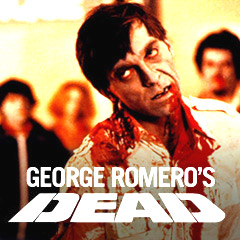
|
Franchises of All Time George Romero's 'Living Dead' Films Night of the Living Dead (1968) |
|
Night of the Living Dead (1968) Film Plot Summary The notorious film of brutal and relentless claustrophobic horror began, under the credits, with Barbra (Judith O'Dea) and her brother Johnny (Russell Streiner), two bickering siblings arguing about the long journey from Pittsburgh, arriving after a three hour drive in their two-door Pontiac at an abandoned cemetery in rural western Pennsylvania to visit their father's grave. It was almost 8 pm on a Sunday evening, but still light outside due to daylight savings time. As they got out for their annual trek to the gravesite with a memorial cross or wreath of flowers, thunder and lightning threatened. In the memorable and haunting graveyard sequence, Johnny teased his sister about being afraid with a Boris Karloff-like voice, and told her: "They're coming to get you, Barbra... They're coming for you, Barbra...They're coming for you. Look, there comes one of them now." A staggering, stumbling, pale-faced zombie figure (S. William Hinzman) in a disheveled suit approached and then attacked Barbra - and also Johnny when he came to her defense. He was killed as they struggled when he fell and his head struck a tombstone. The zombie pursued the helpless Barbra, first to their car where she found that she didn't have the key. She locked herself in for protection (until the zombie rocked the car back and forth and then broke a window with a large stone). She released the car's brake and gears to coast downhill, but when the car side-swiped a tree, she was forced to abandon it and run down the deserted road to a nearby, isolated two-story farmhouse for refuge. During her exploration of the empty house, she grabbed a large butcher knife in a kitchen drawer for protection, and she attempted to phone for help but the line was dead. From a window, she noticed that an additional army of ravenous, trance-like zombies were approaching the outside of the house. At the top of the staircase, she discovered a half-eaten, partially-mutilated body of a female. As she panicked and fled from the house, she was flooded by the bright headlights of a pickup truck driven by another fugitive from the zombies, a capable black man named Ben (Duane Jones), who was running out of gas with a pickup he had found abandoned, and was forced to stop there. After beating off her attacker, he joined her in the house and assured her: "It's all right. Don't worry about him. I can handle him. Probably be a lot more of them as soon as they find out about us," although Barbra appeared unable to speak. After he saw the corpse, he told her: "We've gotta get out of here. We have to get where there's some other people." He couldn't answer her repeated question about the nightmarish situation they faced: "What's happening?" The ghouls broke the headlights on Ben's truck, as he went out to beat them down and stab them. Another zombie gained entry into the house and threatened Barbra, forcing Ben to wrestle him and strike him in the forehead with his tire iron. Barbra stared down at the face of the dead ghoul, noting that it moved until she realized that Ben was dragging the body across the floor, as he told her: "Don't look at it." Outdoors, he set the body on fire to intimidate and scare off the other zombie creatures who were afraid of flames. Knowing that they were trapped ("They know we're in here now") and surrounded inside, Ben decided to board up and barricade the doors and windows to be secure, with Barbra's help, although he realized she was so traumatized that she wouldn't be much help - he told her: "We'll be all right here till someone comes to rescue us" - but they had to work together, he stressed. As he was securing the house with pieces of dismantled furniture and wooden boards, they shared their experiences. He told how he witnessed an unexplainable attack by ten or fifteen zombies upon a gasoline truck that was on fire down the road near a besieged and surrounded Beekman's Diner. As the only survivor, he described how he plowed over an immovable 'undead' group of between fifty or sixty creatures with the pickup truck: "They didn't move! They didn't run, or... they just stood there, staring at me! I just wanted to crush them...They scattered through the air like bugs." As Barbra recollected her own horrific encounter with the zombie in the cemetery, she became extremely agitated and in shock and denial. When she insanely pleaded: "We have to go out and get Johnny...Please help me," Ben refused: "Don't you know what's going on out there? This is no Sunday School picnic." He told her that Johnny was already dead. She slapped him, and he punched her back in the face, rendering her unconscious and incapacitated on the sofa. He flipped on the antique Zenith radio in the living room, and heard a reporter - during a lengthy broadcast, speak about the continuing crisis: an "obvious threat to untold numbers of citizens." The mass media emphatically emphasized the panic and threat. He listened to the news of an "epidemic of mass murder" being committed by a virtual army of unidentified assassins with no apparent pattern or reason for the slayings. It was a "sudden general explosion of mass homicide." The assassins were "ordinary looking people" in a trance-like state, and law enforcement officials were completely overwhelmed and bewildered by the situation of "mayhem" and "wholesale murder." Eastern and Midwestern communities in the eastern third of the nation were affected, and citizens were encouraged to remain in their homes behind locked doors. Ben resourcefully lit a fire in the fireplace and then used a makeshift flaming torch (constructed from a table leg) to ignite an armchair doused in lighter fluid that he had dragged outside - to scare off the attackers. Ben was exhausted after solidly boarding up and securing all windows and entrances into the house, and paused for a cigarette. He was relieved to discover a rifle in a closet and a shoebox filled with ammunition, as Barbra awoke. He felt confident about their security, the gun, their food, and their contact with the outside world through the radio, and believed that they were bound to be rescued. Catatonic, Barbra couldn't respond, as he told her: "Everything's all right for now," although the radio's most recent ghastly report was that murder victims were being devoured by their murderers - evidence of cannibalism: ("the killers are eating the flesh of the people they murder"). Upstairs, as Ben dragged the decaying corpse to one of the rooms, survivors who had been hiding in the cellar startled Barbra as they emerged into the living room. There were the male counterparts of two couples who had fled from the zombies (when the Cooper's car was overturned), identified as husband Harry Cooper (producer Karl Hardman), and teenaged Tom (Keith Wayne). The domineering, loud-mouthed, know-it-all Harry insisted the safest place was in the basement if they boarded up the one entryway, although Ben disagreed ("the cellar is a death-trap"), as they carried on a lengthy argument. There were unspoken racial and generational tensions between Ben and the less capable, older white family man. Ben was angry that the newcomers hadn't volunteered to help him when he was feverishly working to protect the home. Harry's wife Helen Cooper (Marilyn Eastman) and their injured, ill daughter Karen Cooper (Kyra Schon) - bitten earlier on the arm by one of the ghouls - remained in the cellar. Eight to ten rotting-flesh zombies with outstretched arms were seen approaching the house - and as Ben walked by a partially-boarded up window in the kitchen, in a jump-out-of-your-seat moment, hands reached out to grab at him. Ben fired rifle shots at the intruders, but the body shots were mostly ineffective. Dozens of zombies emerged, including one nude female from the morgue with a burial tag still attached to her wrist, and another one who ate a squirming worm off a tree trunk. Ben bluntly told Harry that he was remaining upstairs: "You can be the boss down there. I'm boss up here...I'm not boxing myself in down there." Tom summoned his pretty girlfriend Judy (Judith Ridley) to join him upstairs, while Harry locked himself up in the basement with his wife and daughter. Harry's wife Helen, obviously in a troubled and frustrating relationship with her husband and exasperated by him, objected to being locked down in the cellar - a "dungeon" without access to the radio. After Tom announced that Ben found a television set upstairs, Helen decided to join the others there. The television was brought into the living room, where the group assembled to listen to another broadcaster describe how the first reports from eyewitnesses had been met with disbelief. National Civil Defense Headquarters in Washington DC also reported that the "undead" were coming back to life in funeral homes, morgues, cemeteries, and hospitals and were seeking human victims. People were encouraged to make their way to rescue stations that had been set up to provide food, shelter, medical treatment and protection by armed National Guardsmen. Space and military experts and scientists hypothesized that the crisis may have developed as the result of a returning, disintegrating Venus space probe/satellite that was deliberately exploded in the Earth's atmosphere by NASA when it was discovered that it was carrying a high level of radiation. The broadcaster asked: "Could that radiation be somehow responsible for the wholesale murders we're now suffering?" There were debatable, uncertain opinions about whether or not there was a "definite connection" between the freakish release of a high degree of radiation from the Venus probe to cause molecular mutation - evidenced by ghouls rising from the dead, killing people, and eating them, and the many instances of crazed mass murder. The broadcast continued, with a university official reporting that corpses needed to be cremated immediately, without time for bereavement or a funeral, before they reverted or reactivated in a matter of minutes to flesh-eating zombies. After the broadcast, the group decided that their best solution was to reach a local rescue station - the nearest one on the scrolling list displayed on the TV was Willard Medical Center, about 17 miles away from their location, to seek medical attention for Karen. Ben proposed an escape plan that involved creating Molotov cocktails (with fruit jars filled with kerosene and strips of cloth as fuses), to be hurled from an upper window, to keep the zombies away while they fueled the pickup truck at the farmhouse's outdoor gas pump. As planned, Harry tossed the fire bombs from the upstairs window (setting a few zombies on fire and intimidating others), while Ben and Tom (accompanied by Judy, fearing for Tom's life, who rushed to join their daring plan at the last minute) drove the pickup truck to a gas pump a few hundred yards away. Tom accidentally splashed gasoline onto a torch that Ben had placed on the ground next to the truck - and as Tom tried to drive the flaming truck away from the pumps to prevent further damage (with Judy's jacket caught inside the cab), it exploded in an engulfing ball of fire and they were both killed. Ben held off the zombies with a torch as he rushed back to the house, but found that Harry was so terrified that he had been locked out. Ben kicked open the door and after securing the door, fiercely beat Harry with four punches ("I oughta drag you out there and feed you to those things," he threatened). Outside, the voracious zombies converged on the corpses of Tom and Judy and consumed their charred body parts, bone fragments, internal organs and entrails. Another report on the TV at 3:00 am described how the levels of radiation were still steadily rising - implying that the danger would exponentially increase, and more "flesh-eating ghouls" would develop from reanimated corpses: "So long as this situation remains, government spokesmen warn that dead bodies will continue to be transformed into the flesh-eating ghouls. All persons who die during this crisis, from whatever cause, will come back to life to seek human victims. Unless their bodies are first disposed of by cremation." The report included an in-depth look at a 'search and destroy' mission that was underway to destroy the marauding ghouls by local Sheriff McClelland (George Kosana) in Butler County, Pennsylvania. His posse of white men with rifles had reported to the Pentagon's Command Center that the only methods that were effective in permanently killing the deadly horde were a gunshot or heavy blow to the brain or by incineration: "A ghoul can be killed by a shot in the head or a heavy blow to the skull. Officials are quoted as explaining that since the brain of a ghoul has been activated by the radiation, the plan is, kill the brain and you kill the ghoul."
They were working their way toward Willard (and hoping to wrap up in 24 hours) to team up with the National Guard. Later after the lights went out due to downed power lines, and Ben defended the house from further attempts of the ghouls to break in, Harry struggled to get control of Ben's dropped rifle in order to take charge. After grabbing the rifle and taunting Ben, Harry ordered his wife to the cellar, but then the two men wrestled for possession of the weapon [a phallic symbol of sorts]. Ben seized the gun and lethally shot Harry in the abdomen, point-blank, and he stumbled into the cellar to die. After being assisted by Barbra, Helen also retreated to the cellar where she found her ghoul-bitten young daughter Karen consuming her husband's corpse. In a gory and startling scene, as Helen cried out: "Poor baby," she was viciously stabbed with a triangular garden or cement trowel (often taken to be a social metaphor for the late 1960s youth of the nation rebelling against their elders), and then eaten by her daughter. Upstairs during further 'undead' attacks, Barbra's zombified brother Johnny grabbed her and pulled her outside, where she disappeared into the middle of the horde. Overpowered and surrounded, Ben turned and saw Karen attacking him, but pushed her aside and protectively locked himself in the cellar. Ironically, this was the one thing he had vowed not to do -- as the ghouls took over the house. To prevent the corpses of Harry and Helen from becoming reanimated ghouls, he shot both of them in the head, and then waited until morning to be rescued. The tragic ending came from the actions of real mindless 'zombies' -- rednecks involved in 'search and rescue' missions, who came upon the farmhouse and saw the burned truck and its occupants. Sheriff McClelland noted: "Somebody had a cook-out here." By film's end, one of the townsfolk in the posse mistakenly shot sole surviving black man Ben in the forehead after his desperate fight for survival, believing him to be one of the 'living dead' as he stood near the farmhouse's living room window (Sheriff McClelland: "Hit him in the head, right between the eyes. Good shot. OK, he's dead. Let's go get him. That's another one for the fire"). Under the credits (in a series of still frame shots), his body was dragged from the house with a meat hook and burned in a pyre of other bodies in a field, as the downbeat film ended hopelessly. The film's despairing tone, especially its tragically ironic ending, struck audiences as a true depiction of the lifeless dehumanized society in which people lived. Film Notables (Awards, Facts, etc.) This was George Romero's (known as the Master of the 'zombie film') most notable horror film -- his calling card. He ushered in the modern era of graphically violent and gory zombie pics in the waning years of the 60s decade. Romero's first Dead film appeared at the same time as civil unrest, Black Power and student protests, the Vietnam War, fear of nuclear annihilation, the gruesome assassinations of Robert Kennedy and Martin Luther King, Jr., and the breakdown of the family - all coupled with the idealistic innocence of the previous year's Summer of Love. Romero realized that his archetypal zombie narratives, with extreme blood, violence and gore, could also provide worthwhile sub-textual commentary on societal themes. He recognized that the ultimate in horror was humanity itself ("I also have always liked the monster-within idea. I like the zombies being us"), allegorically presented during turbulent times as mobs of mindless reanimated 'living dead' creatures. This debut film was an influential, milestone 'splatter' film. The ultra-low budget film was shot in grainy 35 mm black-and-white with natural lighting and hand-held cameras to accentuate the fear facing the besieged farmhouse occupants. It featured an unknown cast - and reinvented the genre with its crude "drawbacks" which actually improved the film since they lent a documentary feel and reality that made the film all the more horrific. Zombies were indiscriminate, flesh-eating ghouls (not produced by voodoo rites, or outer space mutants), which Romero himself defined as average-Joe "blue-collar monsters," who lumbered stiffly out of their graves and toward a barricaded house in rural Pennsylvania. The terror came from their relentless attack on innocent fugitive survivors who were hiding to escape being infected by zombie bites. Soon, the horror threat was coming from inside the house as well as outside, as there was a struggle for power between a resourceful and calm black man (the lead character!) and an impulsive family man. It also showed violated bodies and families torn apart by the 'living dead' creatures who illustrated how nothing was sacred in contemporary society (an adolescent girl killed her own mother with a garden trowel and then ate her). While initially considered drive-in schlock, the film gained in popularity and critical respect, and raised Romero to great heights as a horror filmmaker. Romero's Dead trilogy told about flesh-eating zombies who walked slowly and stiffly (due to the effects of rigor mortis), in a 'cult of the dead'. The screenplay was taken from an unpublished short story Romero had written called Anubis, so-named after the Egyptian god of the dead. Director Romero and co-writer John Russo acknowledged that Richard Matheson's 1954 novella I Am Legend was an inspiration for their script. This first film (in a long series) had a production budget of $114,000, but grossed $12 million (domestic) and $30 million (worldwide). With the tagline: "They Won't Stay Dead." The amateurish, allegorical film was made in just one month. It was remade as Night of the Living Dead (1990) by Tom Savini, with a revised screenplay written by George Romero (with a reworked beginning and ending). A second film with the same title was also made in 3-D by director Jeff Broadstreet: Night of the Living Dead 3-D (2006). |
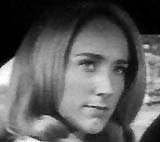 Barbra (Judith O'Dea) 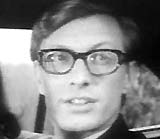 Johnny (Russell Streiner) 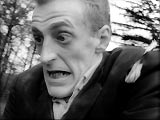 Cemetery Zombie (S. William Hinzman) 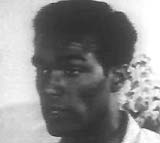 Ben (Duane Jones) 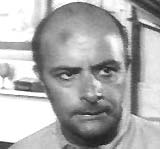 Harry Cooper (Karl Hardman) 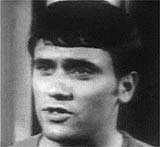 Tom (Keith Wayne) 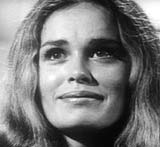 Judy (Judith Ridley) 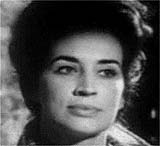 Helen Cooper (Marilyn Eastman) 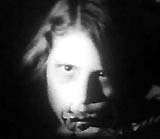 Karen Cooper (Kyra Schon) 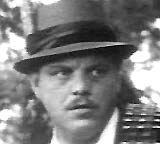 Sheriff McClelland (George Kosana) |